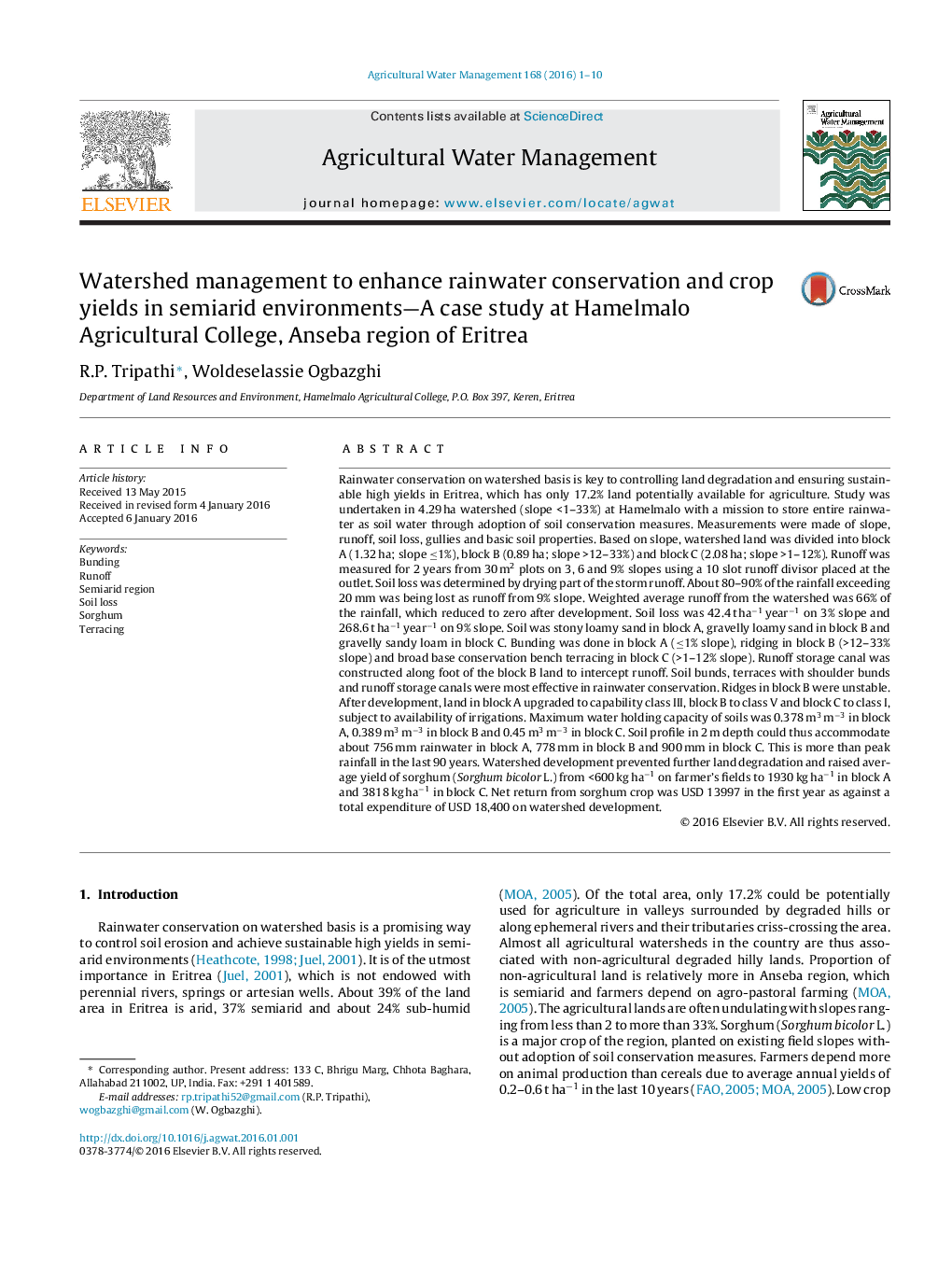| کد مقاله | کد نشریه | سال انتشار | مقاله انگلیسی | نسخه تمام متن |
|---|---|---|---|---|
| 6363555 | 1622912 | 2016 | 10 صفحه PDF | دانلود رایگان |
عنوان انگلیسی مقاله ISI
Watershed management to enhance rainwater conservation and crop yields in semiarid environments-A case study at Hamelmalo Agricultural College, Anseba region of Eritrea
ترجمه فارسی عنوان
مدیریت آبخیزداری برای افزایش حفاظت از باران و تولید محصولات در محیط های نیمه خشک - مطالعه موردی در کالج کشاورزی همیلمالو، منطقه انستا اریتره
دانلود مقاله + سفارش ترجمه
دانلود مقاله ISI انگلیسی
رایگان برای ایرانیان
کلمات کلیدی
موضوعات مرتبط
علوم زیستی و بیوفناوری
علوم کشاورزی و بیولوژیک
علوم زراعت و اصلاح نباتات
چکیده انگلیسی
Rainwater conservation on watershed basis is key to controlling land degradation and ensuring sustainable high yields in Eritrea, which has only 17.2% land potentially available for agriculture. Study was undertaken in 4.29 ha watershed (slope <1-33%) at Hamelmalo with a mission to store entire rainwater as soil water through adoption of soil conservation measures. Measurements were made of slope, runoff, soil loss, gullies and basic soil properties. Based on slope, watershed land was divided into block A (1.32 ha; slope â¤1%), block B (0.89 ha; slope >12-33%) and block C (2.08 ha; slope >1-12%). Runoff was measured for 2 years from 30 m2 plots on 3, 6 and 9% slopes using a 10 slot runoff divisor placed at the outlet. Soil loss was determined by drying part of the storm runoff. About 80-90% of the rainfall exceeding 20 mm was being lost as runoff from 9% slope. Weighted average runoff from the watershed was 66% of the rainfall, which reduced to zero after development. Soil loss was 42.4 t haâ1 yearâ1 on 3% slope and 268.6 t haâ1 yearâ1 on 9% slope. Soil was stony loamy sand in block A, gravelly loamy sand in block B and gravelly sandy loam in block C. Bunding was done in block A (â¤1% slope), ridging in block B (>12-33% slope) and broad base conservation bench terracing in block C (>1-12% slope). Runoff storage canal was constructed along foot of the block B land to intercept runoff. Soil bunds, terraces with shoulder bunds and runoff storage canals were most effective in rainwater conservation. Ridges in block B were unstable. After development, land in block A upgraded to capability class III, block B to class V and block C to class I, subject to availability of irrigations. Maximum water holding capacity of soils was 0.378 m3 mâ3 in block A, 0.389 m3 mâ3 in block B and 0.45 m3 mâ3 in block C. Soil profile in 2 m depth could thus accommodate about 756 mm rainwater in block A, 778 mm in block B and 900 mm in block C. This is more than peak rainfall in the last 90 years. Watershed development prevented further land degradation and raised average yield of sorghum (Sorghum bicolor L.) from <600 kg haâ1 on farmer's fields to 1930 kg haâ1 in block A and 3818 kg haâ1 in block C. Net return from sorghum crop was USD 13997 in the first year as against a total expenditure of USD 18,400 on watershed development.
ناشر
Database: Elsevier - ScienceDirect (ساینس دایرکت)
Journal: Agricultural Water Management - Volume 168, April 2016, Pages 1-10
Journal: Agricultural Water Management - Volume 168, April 2016, Pages 1-10
نویسندگان
R.P. Tripathi, Woldeselassie Ogbazghi,
